Profiling Corrosion Rates for Offshore Wind Turbines with Depth in the North Sea
Abstract
1. Introduction
- Atmospheric zone
- Splash zone
- Submerged zone
- Mud zone
- Mud zone: Differential aeration, microbial-induced corrosion (MIC) and hydrogen induced stress cracking (HISC)
- Waterline: pitting corrosion due to differential aeration
- Stagnant water causing important environmental discrepancies
- Weld defects causing corrosion fatigue and stress corrosion cracking (SCC)
- Acidification if sacrificial anodes are installed
- Accumulation of gases such as H2S, H2 and CH4
2. Field Experiment Design and Deployment
2.1. Assembly
2.2. Deployment and Recovery
3. Results
3.1. Visual Inspection
3.2. Mass Loss and Corrosion Rate
3.3. Chemical Analysis and Implications
3.3.1. SEM and EDS
3.3.2. XRD
4. Discussion
- The trend in corrosion with respect to depth
- The corrosion rate magnitude
5. Conclusions
- A new deployment method has been developed to characterise free corrosion (natural corrosion) to profile the corrosion rate with respect to depth for steel S355, a study that has not been carried out as yet according to the literature.
- The main advantage of using this system is that it reflects the variabilities in the immersed zones without requiring other structures to suspend it to and that water depth does have an influence on the corrosion rate.
- High levels of corrosion rate had been observed that is way above prescribed standards with the highest being at the closest point to the seabed being 0.83 mm/yr. This result though is very similar to the lowest astronomical tide being 0.80 mm/yr. This gave a quadratic function of corrosion rate with respect to tidal depth.
- The highest corrosion rates observed were four times higher than the ones prescribed by the DNV J101-Standards and considerably higher than the field experiments results from 43 other sites.
- Further investigation on the reason behind the trend in corrosion has been done by carrying out the EDS method on the rust particles. Nitrogen at the seabed might have been the reason for the higher corrosion rates.
- After 111 days, the main mechanism of corrosion is still aerobic but traces of sulphur indicate that anaerobic corrosion will happen.
- There were only two arrays recovered out of five and to boost confidence in the results similar experiments will have to be done.
- It is important that the array be strengthened especially for the connection of the lower frame and the anchors by using high strength marine chains rather than ropes to survive the harsh environment of the North Sea.
Author Contributions
Funding
Conflicts of Interest
Appendix A
| Mass/g | Mass Loss/g | Mass Loss/g | |||
|---|---|---|---|---|---|
| Label | Un-Corroded | After without Cleaning | After with Cleaning | Before-After without | Before—After with |
| 1 black | 1661.4 | 1597.6 | 1588 | 63.8 | 73.4 |
| 3 black | 1666.9 | 1615.2 | 1602.4 | 51.7 | 64.5 |
| 1 blue | 1629.9 | 1582.2 | 1574.4 | 47.7 | 55.5 |
| 2 blue | 1647.7 | 1609.1 | 1599.1 | 38.6 | 48.6 |
| 4 blue | 1661 | 1594.3 | 1585.6 | 66.7 | 75.4 |
Appendix B
| 2 Blue | Percentage Weight | ||||||||||||||
|---|---|---|---|---|---|---|---|---|---|---|---|---|---|---|---|
| Statistics | N | Na | Mg | Al | Si | P | S | Cl | K | Ca | Ti | V | Cr | Mn | Fe |
| Max | 0 | 2.54 | 0.44 | 1.22 | 2.34 | 0.28 | 1.33 | 4.21 | 0.43 | 1.2 | 0 | 2.17 | 1.08 | 0.54 | 57.14 |
| Min | 0 | 0.66 | 0.18 | 0.24 | 0.22 | 0.11 | 0.45 | 2.21 | 0.07 | 0.07 | 0 | 0.11 | 0.14 | 0.21 | 36.55 |
| Average | 0 | 1.4 | 0.31 | 0.71 | 1.09 | 0 | 0.79 | 2.9 | 0.3 | 0.46 | 0 | 0 | 0 | 0 | 46.86 |
| 1 black | |||||||||||||||
| Statistics | N | Na | Mg | Al | Si | P | S | Cl | K | Ca | Ti | V | Cr | Mn | Fe |
| Max | 0 | 1.39 | 0.49 | 0.62 | 1.12 | 0 | 0.57 | 3.22 | 0.22 | 0.32 | 0 | 0.28 | 0.2 | 0 | 61.06 |
| Min | 0 | 0.43 | 0.19 | 0.3 | 0.44 | 0 | 0.17 | 0.88 | 0.07 | 0.09 | 0 | 0.28 | 0.2 | 0 | 40.56 |
| Average | 0 | 0.8 | 0.33 | 0.43 | 0.7 | 0 | 0.34 | 1.86 | 0.13 | 0.22 | 0 | 0 | 0 | 0 | 52.55 |
| 4 blue | |||||||||||||||
| Statistics | N | Na | Mg | Al | Si | P | S | Cl | K | Ca | Ti | V | Cr | Mn | Fe |
| Max | 6.5 | 2.52 | 0.81 | 3.23 | 5.58 | 0.63 | 1.23 | 3.22 | 1.08 | 1.51 | 0.18 | 0.67 | 0.72 | 0.35 | 55.83 |
| Min | 4.4 | 1.02 | 0.12 | 0.21 | 0.28 | 0.06 | 0.31 | 1.35 | 0.07 | 0.13 | 0.18 | 0.15 | 0.72 | 0.35 | 4.58 |
| Average | 5.3 | 1.51 | 0.52 | 1.45 | 2.27 | 0.21 | 0.89 | 2.29 | 0.55 | 0.65 | 0 | 0 | 0 | 0 | 39.19 |
| 3 black | |||||||||||||||
| Statistics | N | Na | Mg | Al | Si | P | S | Cl | K | Ca | Ti | V | Cr | Mn | Fe |
| Max | 0 | 0.94 | 0.38 | 1.63 | 2.78 | 0.05 | 0.66 | 2.36 | 0.34 | 0.23 | 0.11 | 0 | 0 | 0.5 | 64.67 |
| Min | 0 | 0.16 | 0.37 | 0.1 | 0.23 | 0.05 | 0.25 | 0.64 | 0.12 | 0.07 | 0.11 | 0 | 0 | 0.5 | 40.69 |
| Average | 0 | 0.53 | 0 | 0.71 | 1.2 | 0 | 0.48 | 1.6 | 0.22 | 0 | 0 | 0 | 0 | 0 | 50.34 |
| 1 blue | |||||||||||||||
| Statistics | N | Na | Mg | Al | Si | P | S | Cl | K | Ca | Ti | V | Cr | Mn | Fe |
| Max | 0 | 2.8 | 1.48 | 4.31 | 11.29 | 0.23 | 2.04 | 4.26 | 1.46 | 3.2 | 0.33 | 0 | 0.93 | 0.41 | 67.36 |
| Min | 0 | 0.54 | 0.26 | 0.49 | 0.46 | 0.04 | 0.31 | 1.34 | 0.19 | 2.34 | 0.33 | 0 | 0.28 | 0.41 | 14.3 |
| Average | 0 | 1.3 | 0 | 1.75 | 4.77 | 0 | 1.09 | 2.53 | 0.68 | 0 | 0 | 0 | 0 | 0 | 38.67 |
References
- De Rucoba, D.F.; Rodríguez, Á.; Arias, R.R. Degradation and corrosion testing of materials and coating systems for offshore wind turbine substructures in North Sea waters. In Proceedings of the International Wind Engineering Conference, IWEC 2014, Hannover, Germany, 3–4 September 2014. No. SEPTEMBER 2014. [Google Scholar]
- Pawsey, C. The Importance of Corrosion Protection on Offshore Wind Farms; Corrosion-Offshore: Brazil, 2015. [Google Scholar]
- JAhuir-Torres, J.; Simandjuntak, S.; Bausch, N.; Farrar, A.; Webb, S.; Nash, A.; Thomas, B.; Muna, J.; Jonsson, C.; Matthew, D. Corrosion threshold data of metallic materials in various operating environment of offshore wind turbine parts (tower, foundation, and nacelle/gearbox). Data Brief 2019, 25, 104207. [Google Scholar] [CrossRef] [PubMed]
- Mehmanparast, A.; Mehmanparast, A.; Kolios, A. Materials selection for XL wind turbine support structures: A corrosion-fatigue perspective. Mar. Struct. 2018, 61, 381–397. [Google Scholar] [CrossRef]
- Ahuir-Torres, J.I.; Bausch, N.; Farrar, A.; Webb, S.; Simandjuntak, S.; Nash, A.; Thomas, B.; Muna, J.; Jonsson, C.; Mathew, D. Benchmarking parameters for remote electrochemical corrosion detection and monitoring of offshore wind turbine structures. Wind. Energy 2019, 22, 857–876. [Google Scholar] [CrossRef]
- Maher, M. Perforated Offshore Monopile for Corrosion Control and Enhanced Marine Habits. Mater. Perform. 2019. Available online: http://resources.nace.org/pdfs/mp-awards/Florida-Institute-Technology-Perforated-Offshore-Monopile.pdf.
- Zhou, S.; Zhu, X.; Yan, Q. One-step electrochemical deposition to achieve superhydrophobic cobalt incorporated amorphous carbon-based film with self-cleaning and anti-corrosion. Surf. Interface Anal. 2017, 50, 290–296. [Google Scholar] [CrossRef]
- Momber, A.W. Corrosion and corrosion protection of support structures for offshore wind energy devices (OWEA). Mater. Corros. 2010, 62, 391–404. [Google Scholar] [CrossRef]
- Plagemann, P.; Momber, A. Corrosion Protection of Offshore Wind Energy Constructions in Germany: Challenges and Approaches. J. Telecommun. Electron. Comput. Eng. 2018, 10, 1–4. [Google Scholar]
- Price, S.J.; Figueira, R.B. Corrosion Protection Systems and Fatigue Corrosion in Offshore Wind Structures: Current Status and Future Perspectives. Coatings 2017, 7, 25. [Google Scholar] [CrossRef]
- Ioannou, A.; Angus, A.; Brennan, F. A lifecycle techno-economic model of offshore wind energy for different entry and exit instances. Appl. Energy 2018, 221, 406–424. [Google Scholar] [CrossRef]
- Lioudis, N. How do average costs compare among various oil drilling rigs? Investopedia 2020, 2020, 1. [Google Scholar]
- Mathiesen, T.; Black, A.; Grønvold, F. Monitoring and Inspection Options for Evaluating Corrosion in Offshore Wind Foundations; NACE Corrosion: Vancouver, CA, Canada, 2016. [Google Scholar]
- Bjørgum, A.; Knudsen, O.Ø. Corrosion protection of offshore wind turbines. In Wind Power R&D Semin; SINTEF: Trondheim, Norway, 2010. [Google Scholar]
- Hilbert, L.R.; Black, A.R.; Andersen, F.; Mathiesen, T. Inspection and monitoring of corrosion inside monopile foundations for offshore wind turbines. Eur. Corros. Congr. 2011 EUROCORR 2011, 3, 2187–2201. [Google Scholar]
- Hilbert, L.R.; Mathiesen, T.; Black, A.R.; Christensen, C.; Technology, F. Mud zone corrosion in offshore renewable energy structures. In Eurocorr 2013; Eurocorr: Portugal, 2013; pp. 1–5. [Google Scholar]
- Dong, X.H.; Yuan, T.J.; Ma, R.-H. Corrosion Mechanism on Offshore Wind Turbine Blade in Salt Fog Environment. Appl. Mech. Mater. 2013, 432, 258–262. [Google Scholar] [CrossRef]
- Zhang, J.; Hertelé, S.; De Waele, W. A Non-Linear Model for Corrosion Fatigue Lifetime Based on Continuum Damage Mechanics. MATEC Web Conf. 2018, 165, 03003. [Google Scholar] [CrossRef]
- Buslov, V. Corrosion of Steel Sheet Piles in Port Structures. J. Waterw. Port Coastal Ocean Eng. 1983, 109, 273–295. [Google Scholar] [CrossRef]
- Mith, M.; Bardiau, M.; Brennan, R.; Burgess, H.; Caplin, J.; Ray, S.; Urios, T. Accelerated low water corrosion: The microbial sulfur cycle in microcosm. Npj Mater. Degrad. 2019, 3, 1–11. [Google Scholar] [CrossRef]
- Melchers, R.E.; Jeffrey, R.J. Corrosion of steel piling in seawater harbours. Proc. Inst. Civ. Eng. Marit. Eng. 2014, 167, 159–172. [Google Scholar] [CrossRef]
- Garcia, A.; Valdez-Salas, B.; Schorr, M.; Zlatev, R.; Eliezer, A.; Hadad, J. Assessment of marine and fluvial corrosion of steel and aluminium. J. Mar. Eng. Technol. 2010, 9, 3–9. [Google Scholar] [CrossRef]
- Valdez-Salas, B.; Ramirez, J.; Eliezer, A.; Schorr, M.; Ramos, R.; Salinas, R. Corrosion assessment of infrastructure assets in coastal seas. J. Mar. Eng. Technol. 2016, 15, 1–11. [Google Scholar] [CrossRef]
- Traverso, P.; Canepa, E. A review of studies on corrosion of metals and alloys in deep-sea environment. Ocean Eng. 2014, 87, 10–15. [Google Scholar] [CrossRef]
- Melchers, R.E.; Jeffrey, R. Effect of Immersion Depth on Marine Corrosion of Mild Steel. Corros. Sci. 2005, 61, 895–906. [Google Scholar] [CrossRef]
- Blekkenhorst, F.; Ferrari, G.M.; Van Der Wekken, C.J.; Ijsseling, F.P. Development of high strength low alloy steels for marine applications: Part 1: Results of long term exposure tests on commercially available and experimental steels. Br. Corros. J. 1986, 21, 163–176. [Google Scholar] [CrossRef]
- Kirk, W.; Pikul, S. Seawater Corrosivity Around the World: Results from Three Years of Testing. Corrosion in Natural Waters 2009, 2. [Google Scholar] [CrossRef]
- ASTM International. Standard Practice for Preparing, Cleaning, and Evaluating Corrosion Test; ASTM International: West Conshohocken, PA, USA, 2017. [Google Scholar]
- Knudsen, O.; Bjørgum, A. New coatings for corrosion protection of offshore wind structures. In Proceedings of the Corrosion Protection for Offshore Wind, Dallas, TX, USA, 15–19 March 2015. [Google Scholar]
- DNV. DNV-OS-J101 Design of Offshore Wind Turbine Structures; Det Norske Veritas: Oslo, Norway, 2014; pp. 212–214. [Google Scholar]
- Powell, C.; Michels, H. Review of Splash Zone Corrosion and Biofouling of C70600 Sheathed Steel During 20 Years Exposure. In Eurocorr 2006; Eurocorr: Netherlands, 2006; pp. 1–18. [Google Scholar]
- Melchers, R.E. Long-term immersion corrosion of steels in seawaters with elevated nutrient concentration. Corros. Sci. 2014, 81, 110–116. [Google Scholar] [CrossRef]

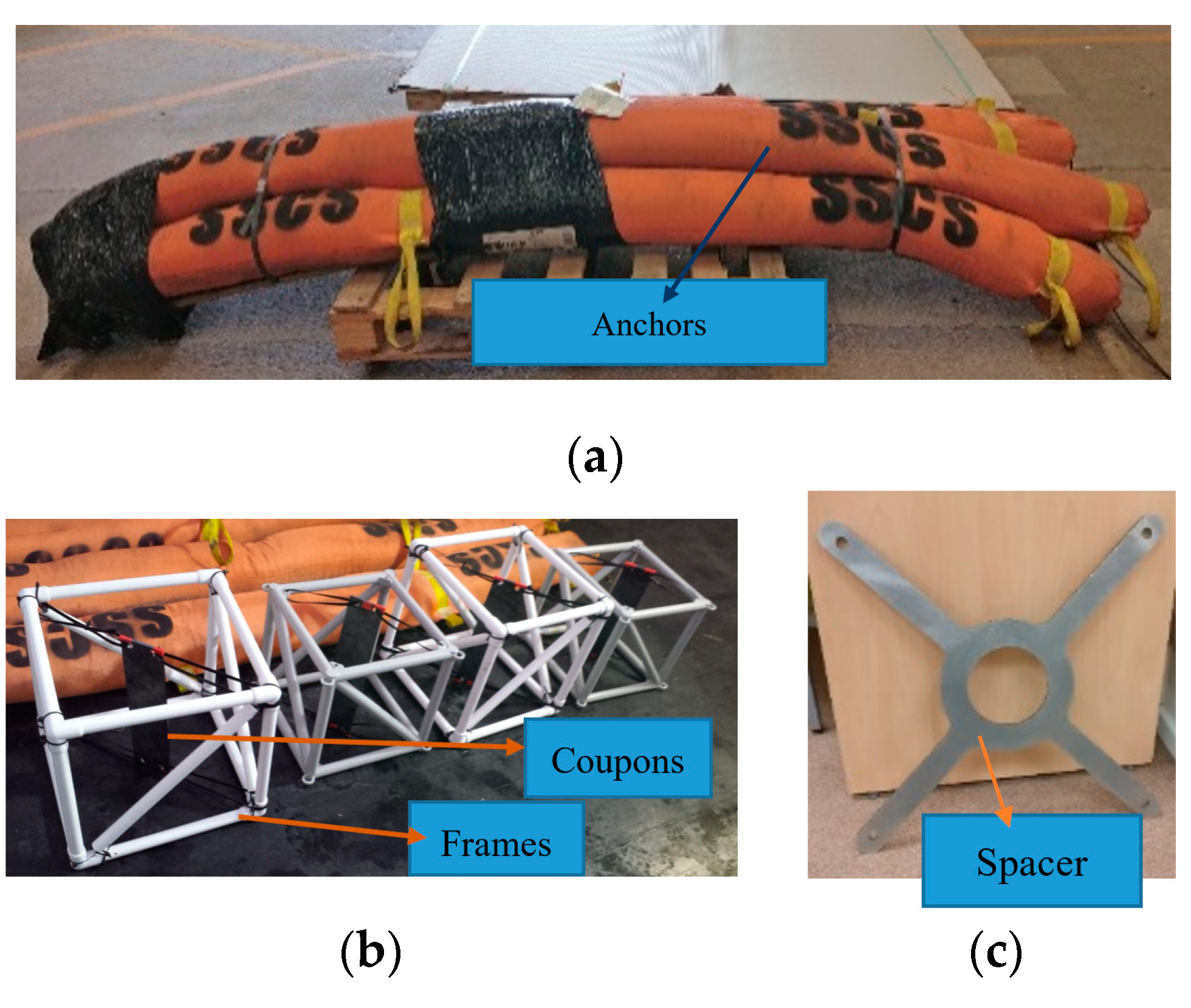

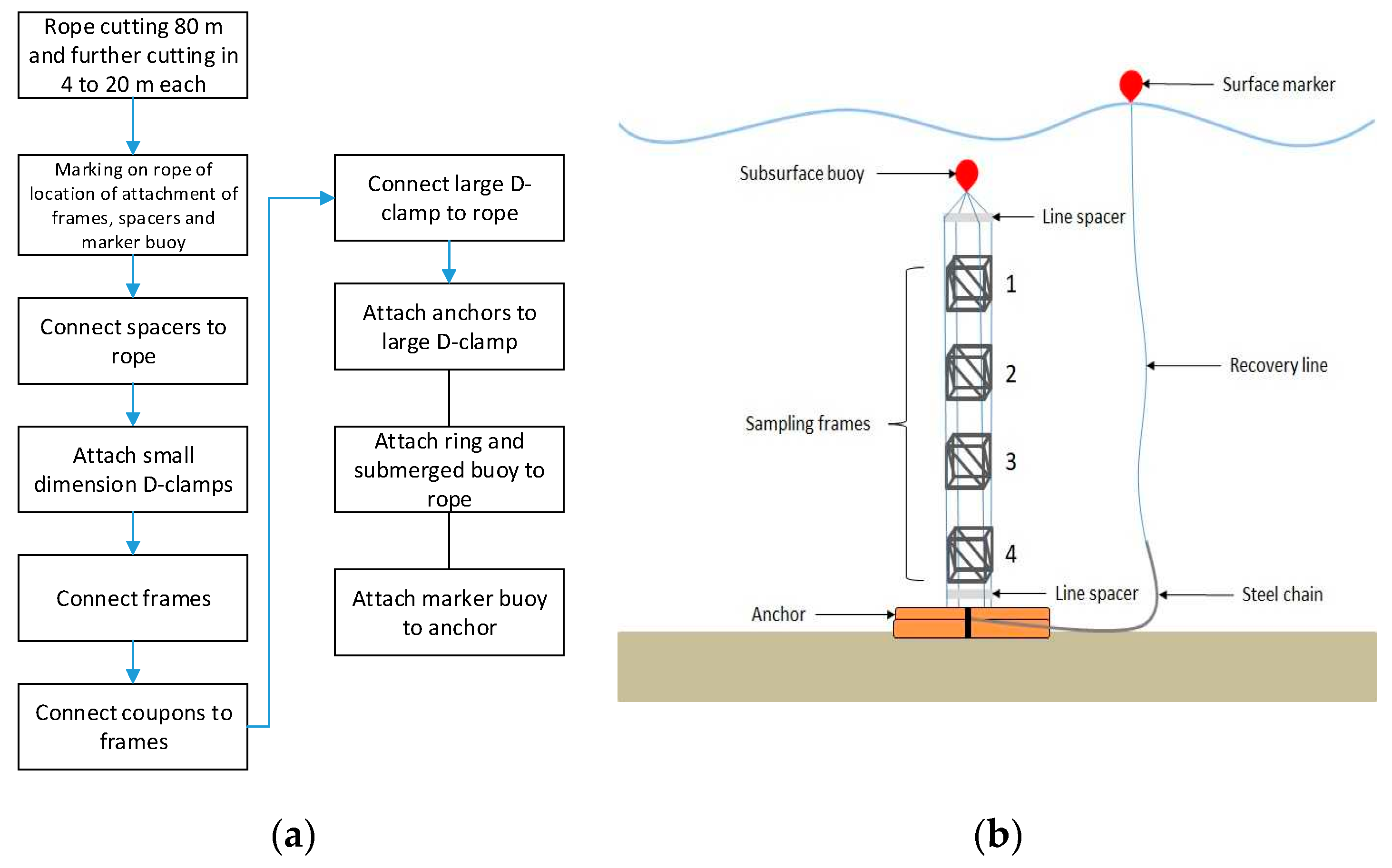
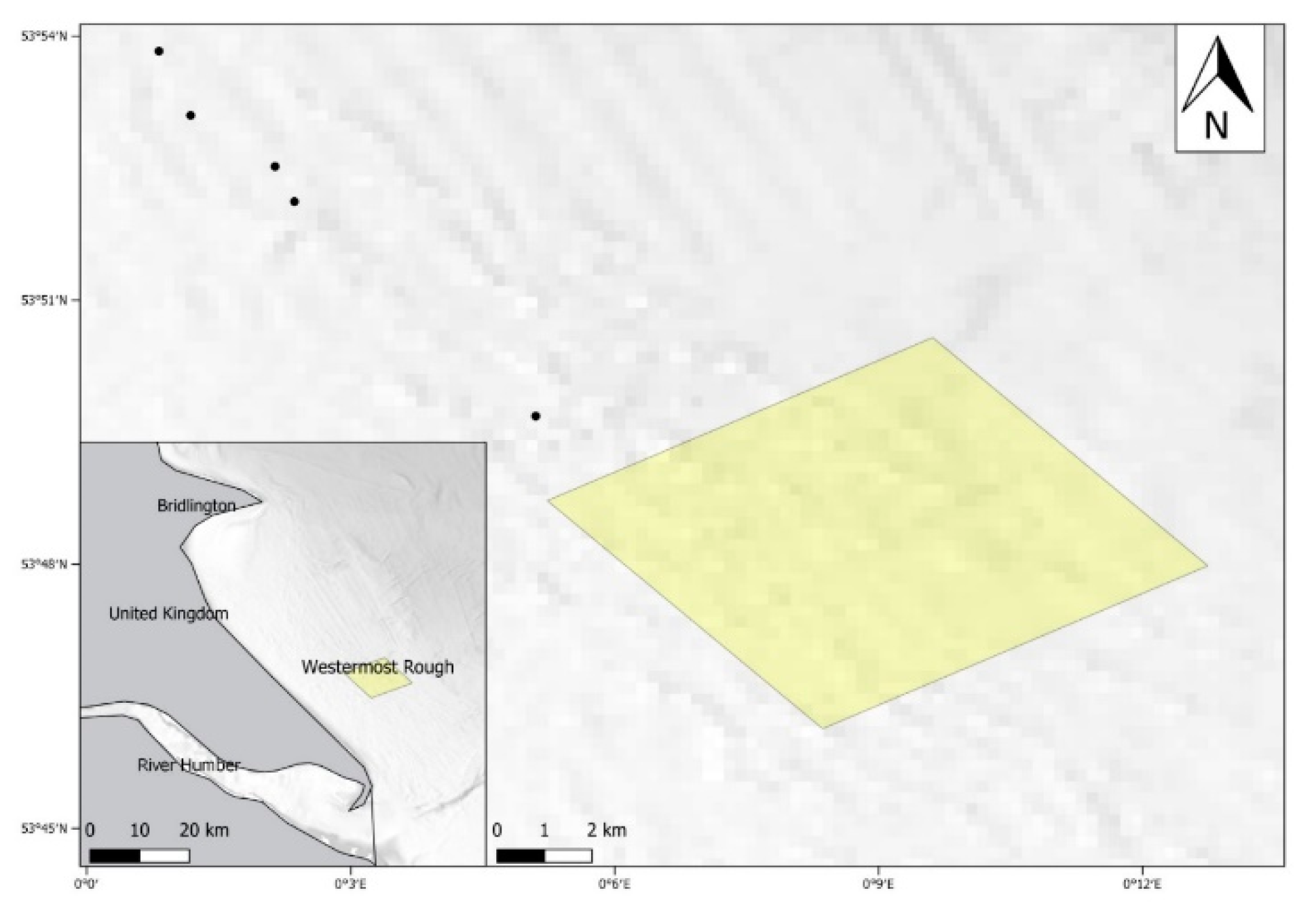
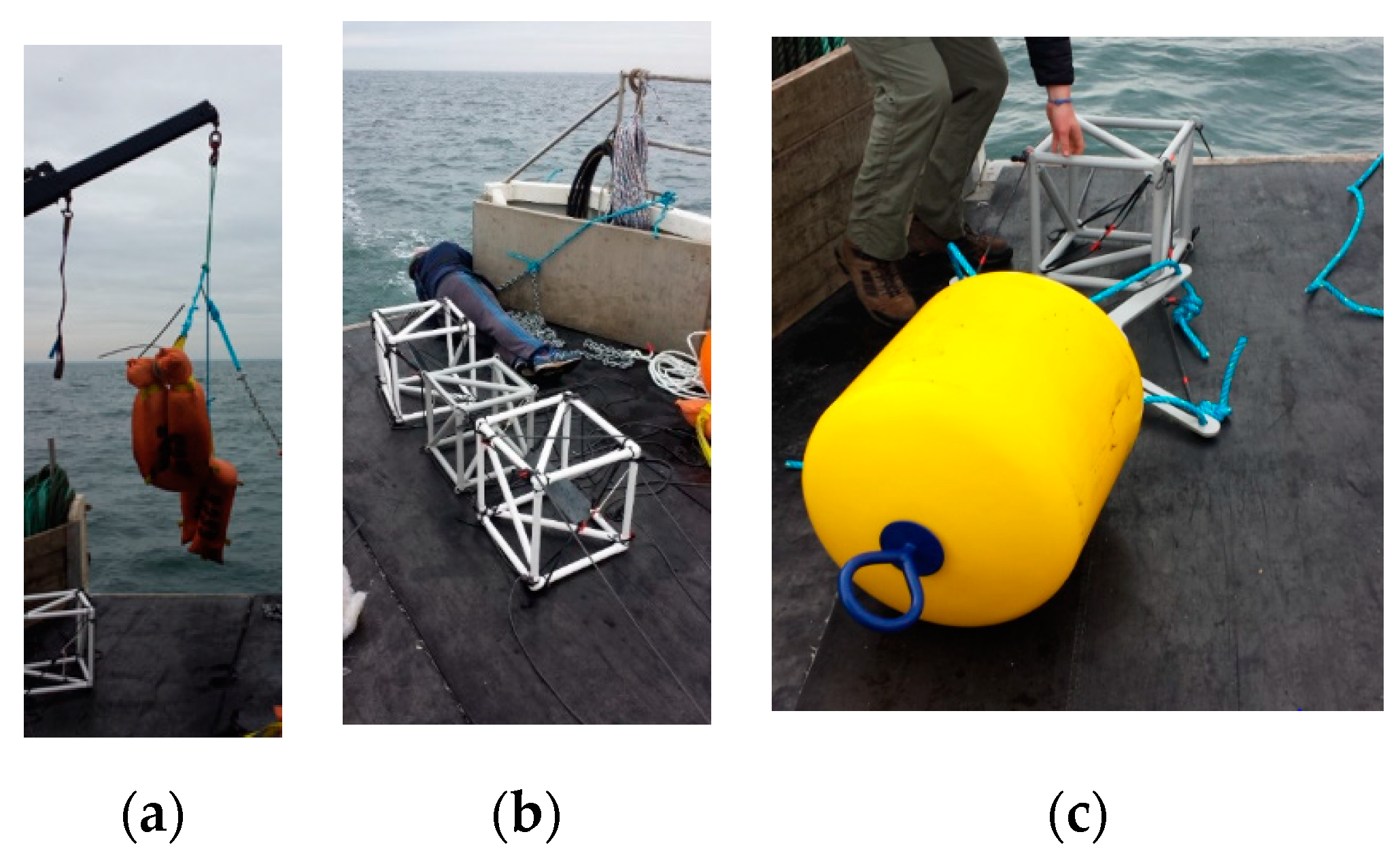


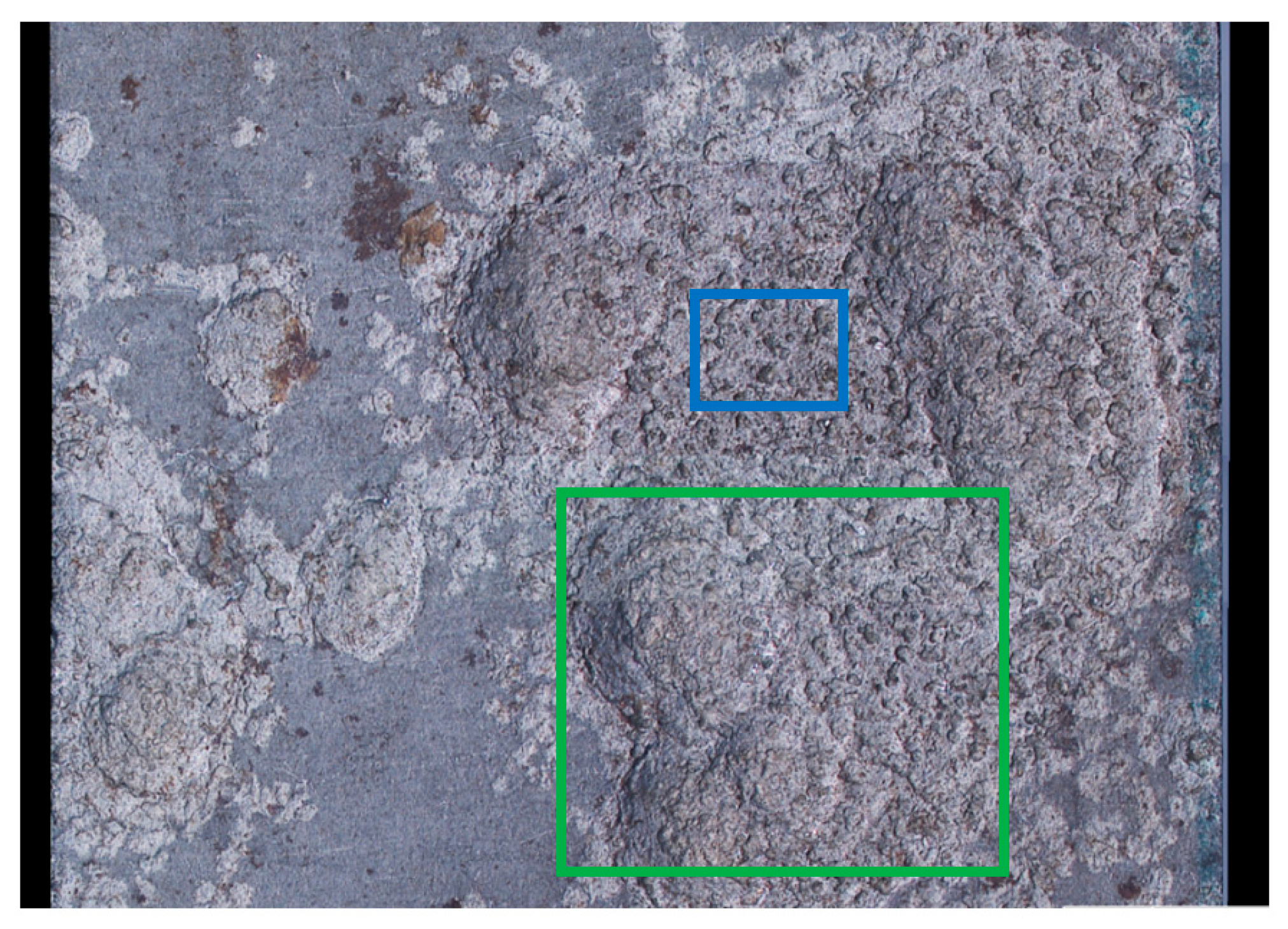
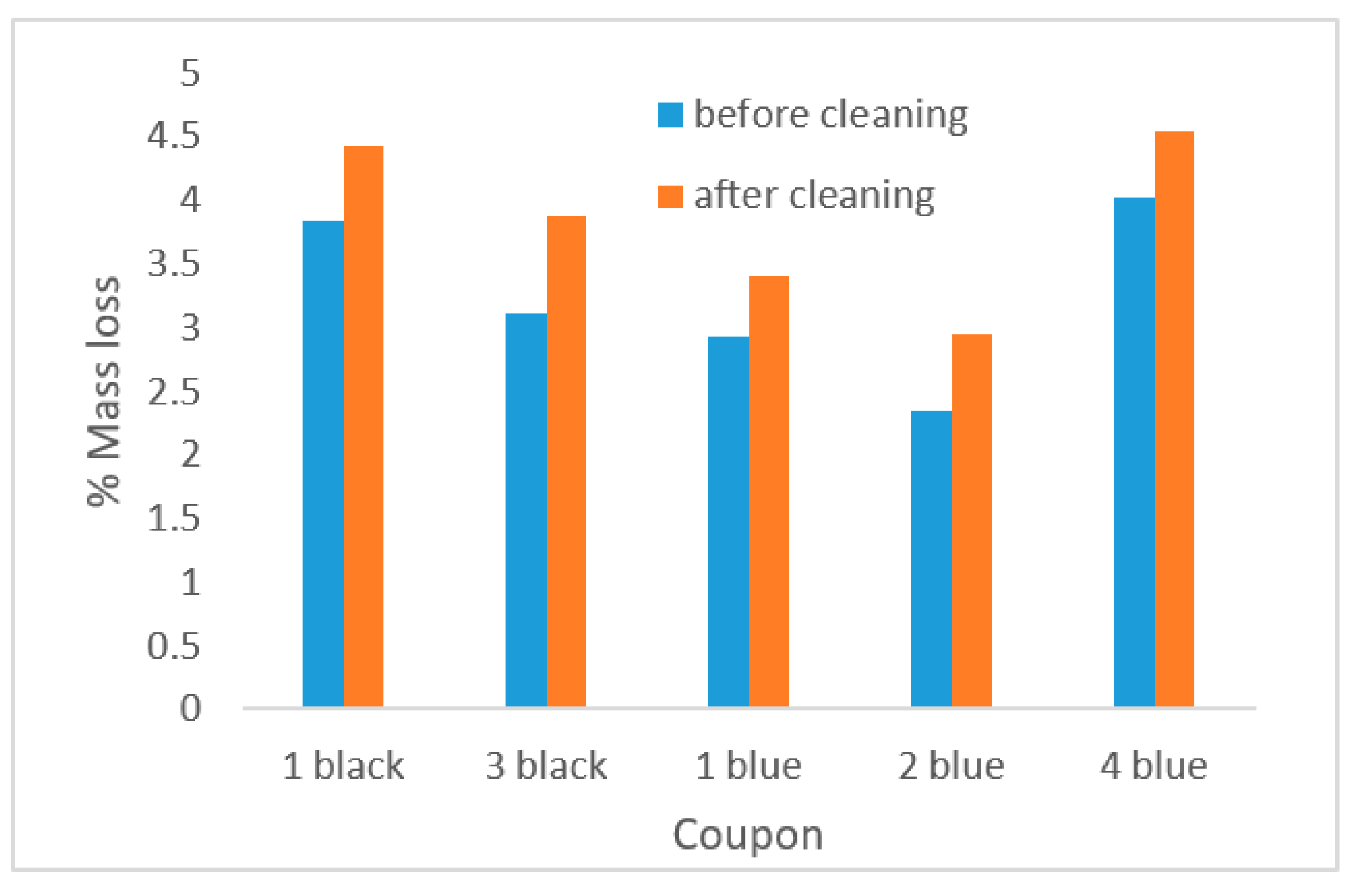
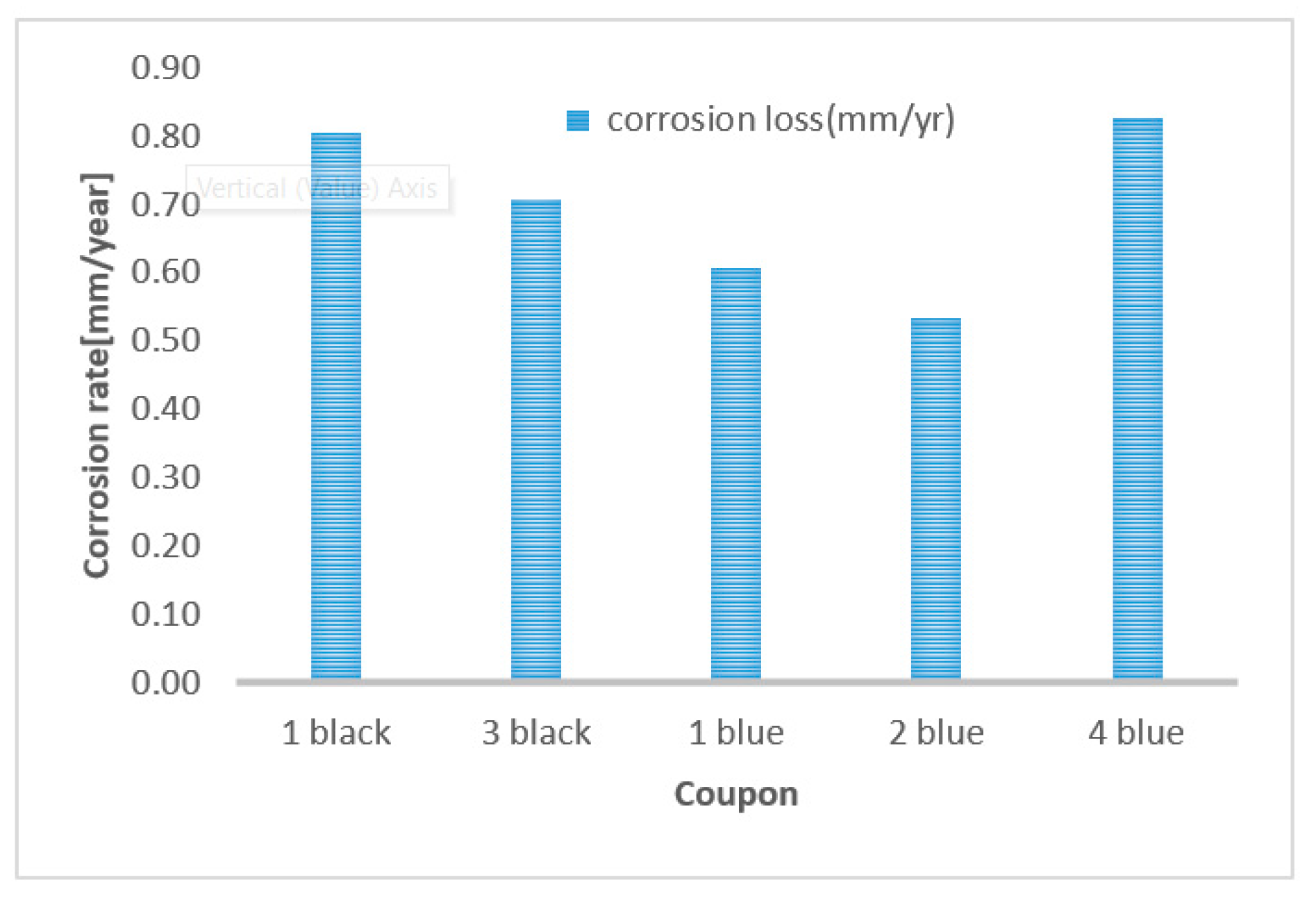



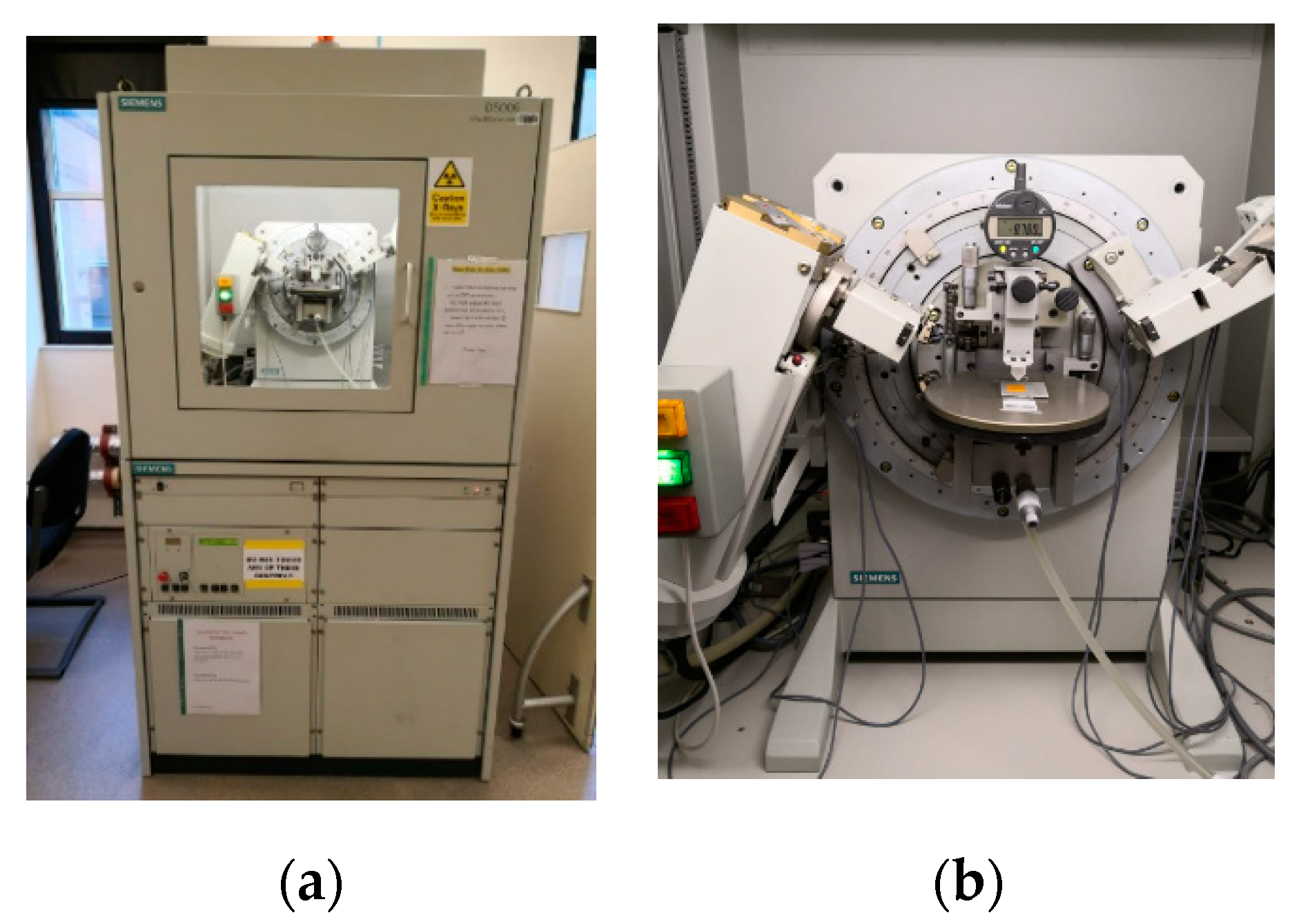

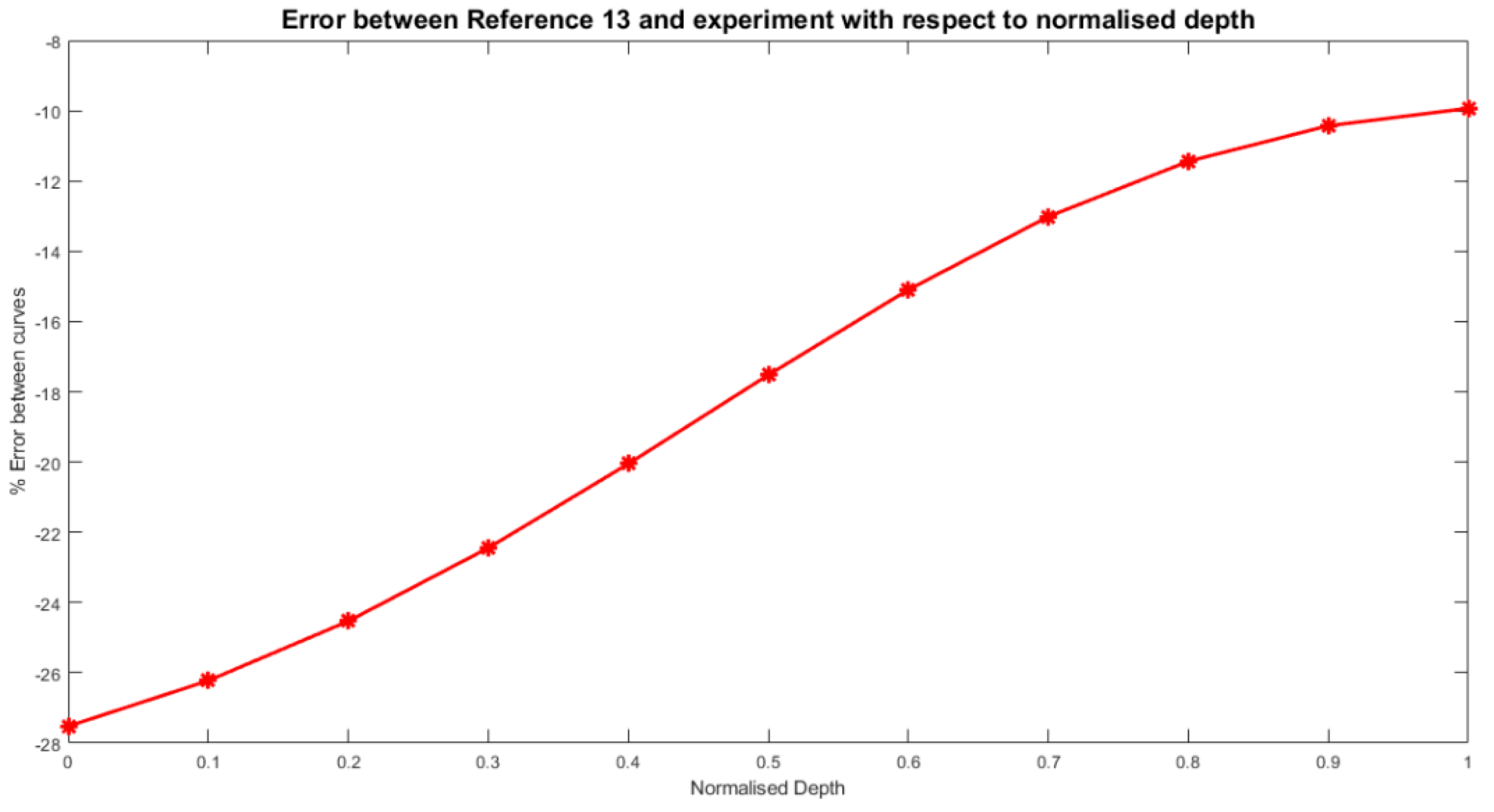
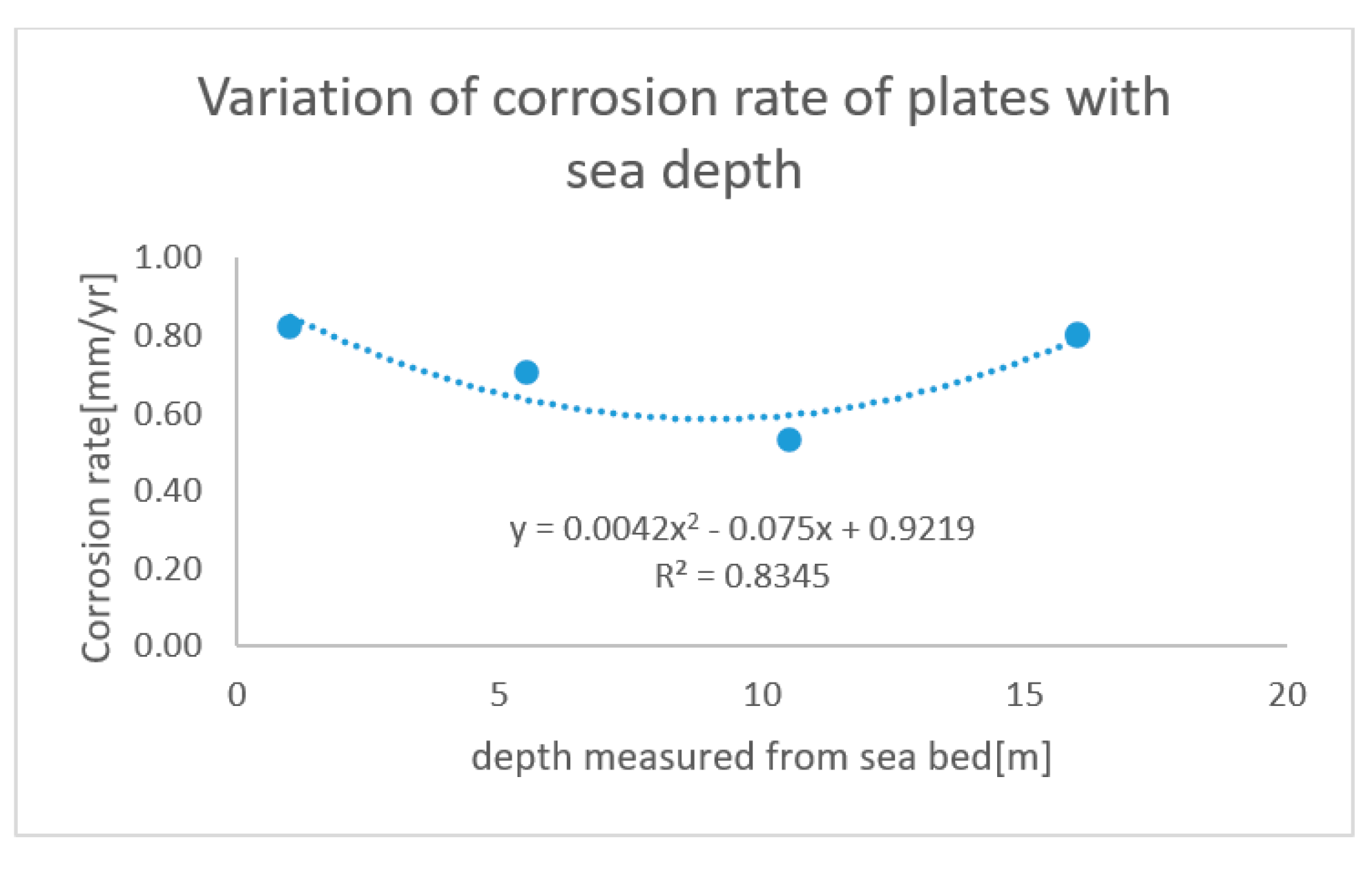
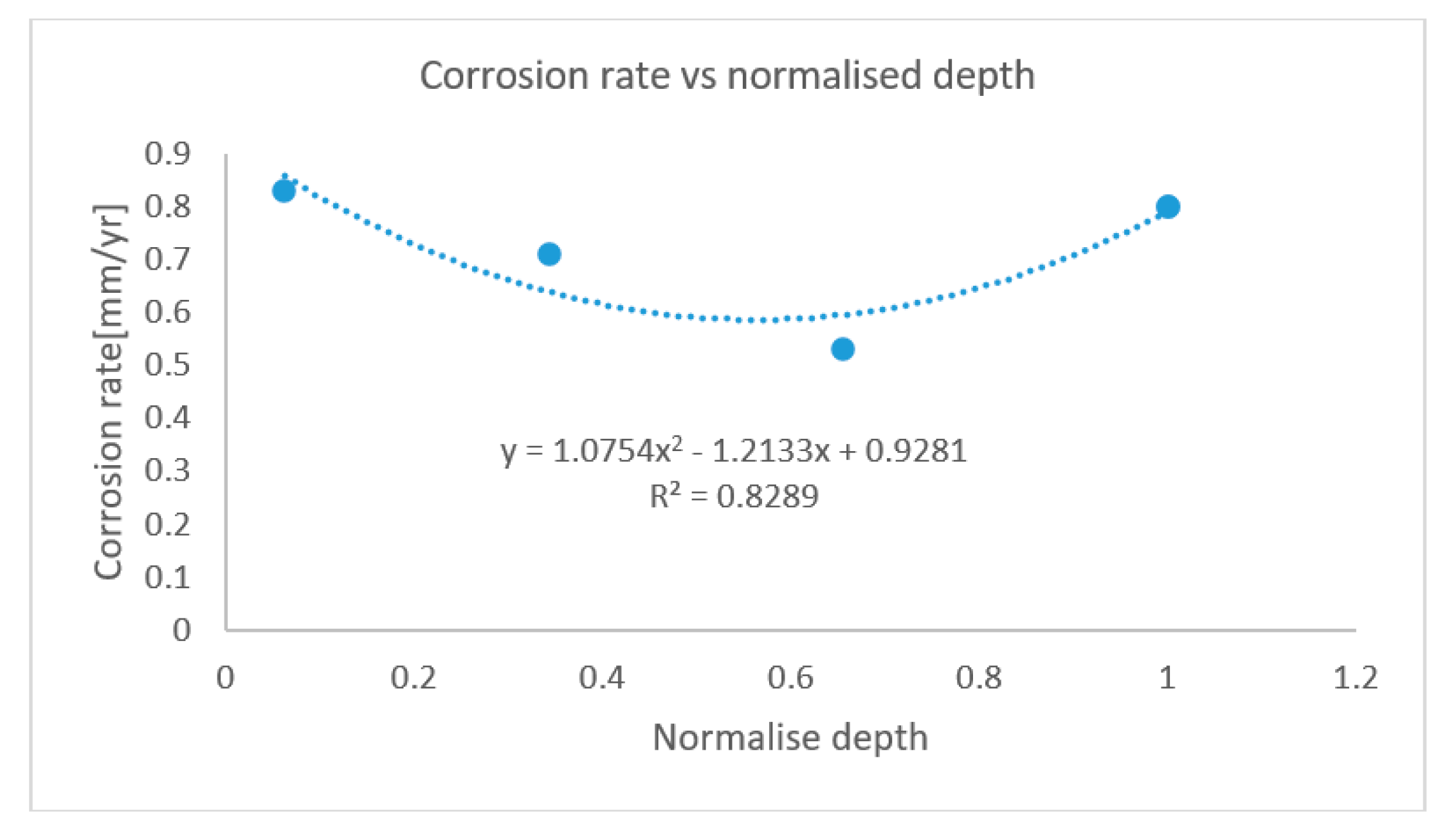
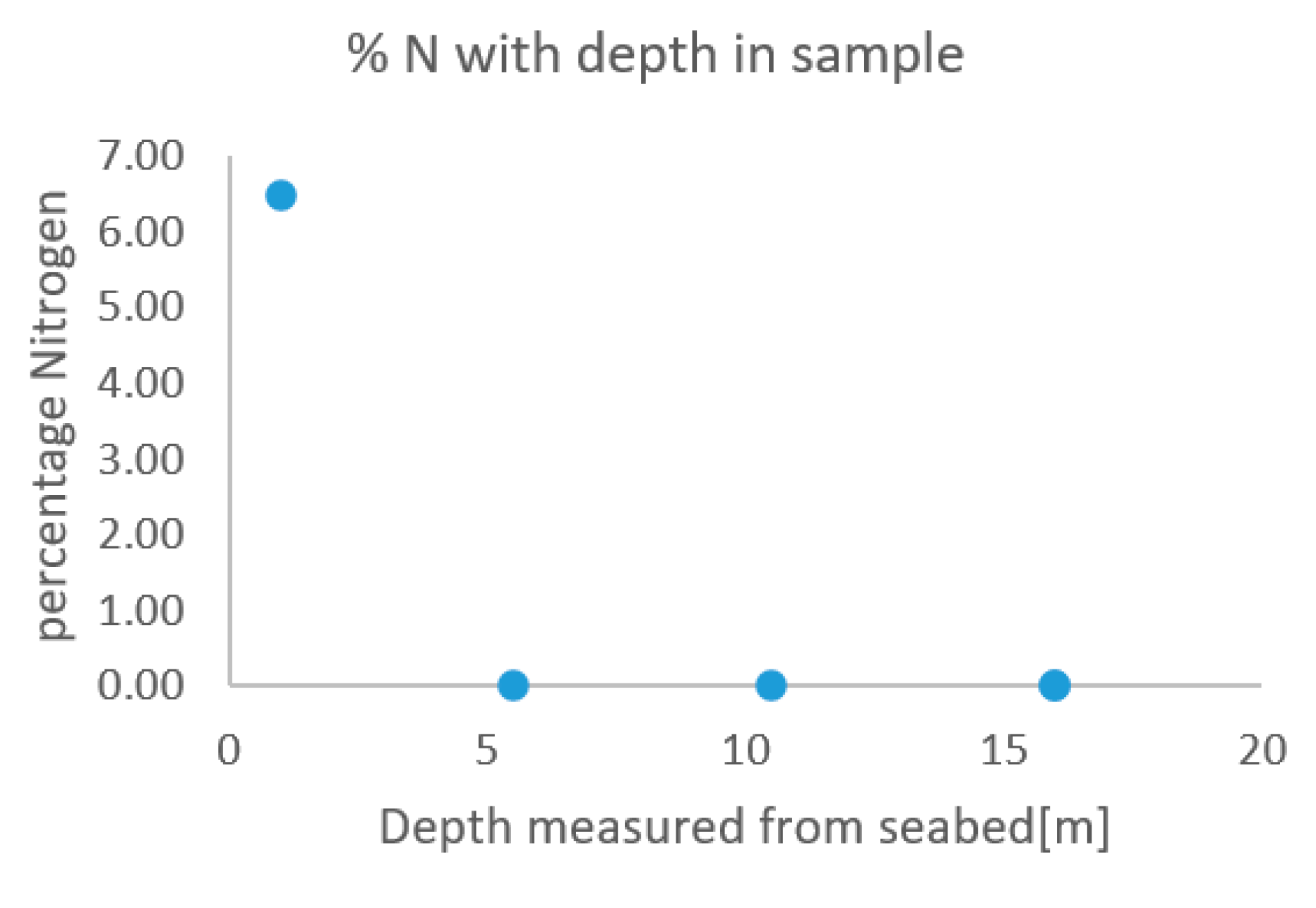
| Plate Number | Height [m] (Distance from Seabed) |
|---|---|
| 1 | 16 |
| 2 | 10.5 |
| 3 | 5.5 |
| 4 | 1 |
| Colour Coded Plate | %N | %S | %Cl | %Fe | Depth [m] |
|---|---|---|---|---|---|
| 2 blue | 0.00 | 0.79 | 2.90 | 46.86 | 10.5 |
| 2 black | 0.00 | 0.34 | 1.86 | 52.55 | 10.5 |
| 4 blue | 6.50 | 0.89 | 2.29 | 39.19 | 1 |
| 3 black | 0.00 | 0.48 | 1.60 | 50.34 | 5.5 |
| 1 blue | 0.00 | 1.09 | 2.53 | 38.67 | 16 |
| Environmental Zone | Corrosion Rate [mm/yr] |
|---|---|
| Buried in soil | 0.06–0.10 |
| Submerged zone | 0.10–0.20 |
| Intermediate Zone | 0.05–0.25 |
| Splash Zone | 0.20–0.40 |
| Atmospheric Zone | 0.050–0.075 |
| Immersed Conditions | ||||
|---|---|---|---|---|
| Location | Country | Exposure Period [Years] | Corrosion Rate [mm/year] | Reference |
| Townsville | Australia | 2.0 | 0.240 | [25] |
| Taylor Beach | Australia | 2.0 | 0.205 | [25] |
| Williamstown | Australia | 1.5 | 0.233 | [25] |
| Queenscliff | Australia | 2.0 | 0.225 | [25] |
| Queenscliff | Australia | 1.2 | 0.458 | [25] |
| Hobart | Australia | 2.0 | 0.230 | [25] |
| Hobart | Australia | 3.0 | 0.233 | [25] |
| Port Arthur | Australia | 2.1 | 0.190 | [25] |
| Boston | USA | 18.0 | 0.064 | [25] |
| Norfolk | USA | 15.0 | 0.098 | [25] |
| Key West | USA | 22.0 | 0.075 | [25] |
| Coco Solo | USA | 24.0 | 0.135 | [25] |
| San Diego | USA | 18.0 | 0.100 | [25] |
| Alameda | USA | 21.0 | 0.075 | [25] |
| Puget Sound | USA | 9.0 | 0.086 | [25] |
| Pearl Harbor | USA | 2.0 | 0.360 | [25] |
| Buzzard Bay | USA | 5.0 | 0.020 | [25] |
| LA Costa Island | USA | 10.0 | 0.000 | [25] |
| Kure Beach | USA | 5.0 | 0.000 | [25] |
| Harbor Island | USA | 5.0 | 0.240 | [25] |
| Tokyo Bay | Japan | 11.0 | 0.136 | [25] |
| Yokohama Port | Japan | 11.0 | 0.182 | [25] |
| Trondheim | Norway | 26.0 | 0.092 | [25] |
| Trondheim | Norway | 24.0 | 0.054 | [25] |
| Port Adelaide | Australia | 52.0 | 0.031 | [25] |
| Harbor Island | USA | 5.0 | 0.250 | [25] |
| Newcastle | UK | 89.0 | 0.007 | [25] |
| Thames Estuary | UK | 8.0 | 0.071 | [25] |
| North Sea | UK | 7.2 | 0.154 | [25] |
| Moreton Bay | Australia | 2.0 | 0.230 | [25] |
| Newcastle Harbour | Australia | 2.2 | 0.123 | [25] |
| Taylor Beach | Australia | 2.2 | 0.136 | [25] |
| Coffs Harbour | Australia | 2.0 | 0.150 | [25] |
| Campeche | Mexico | 0.280 | [23] | |
| New Jersey | USA | 0.5 | 0.213 | [27] |
| 1.0 | 0.322 | [27] | ||
| 3.0 | 0.107 | [27] | ||
| 5.0 | 0.100 | [27] | ||
| North Carolina | USA | 0.5 | 0.165 | [27] |
| 1.0 | 0.213 | [27] | ||
| 3.0 | 0.214 | [27] | ||
| 5.0 | 0.224 | [27] | ||
| Florida | USA | 0.5 | 0.146 | [27] |
| 1.0 | 0.119 | [27] | ||
| 3.0 | 0.124 | [27] | ||
| 5.0 | 0.075 | [27] | ||
| Texas | USA | 0.5 | 0.120 | [27] |
| 1.0 | 0.105 | [27] | ||
| 3.0 | 0.099 | [27] | ||
| 5.0 | 0.137 | [27] | ||
| California | USA | 0.5 | 0.550 | [27] |
| 1.0 | 0.121 | [27] | ||
| 2.9 | 0.173 | [27] | ||
| 5.0 | 0.207 | [27] | ||
| Hawai | USA | 0.5 | 0.240 | [27] |
| 1.0 | 0.536 | [27] | ||
| 3.2 | 0.204 | [27] | ||
| 5.0 | 0.097 | [27] | ||
| Talara | Peru | 0.5 | 0.196 | [27] |
| 1.0 | 0.147 | [27] | ||
| 3.1 | 0.129 | [27] | ||
| 5.0 | 0.136 | [27] | ||
| Sakata Harbor | Japan | 0.5 | 0.089 | [27] |
| 1.0 | 0.171 | [27] | ||
| 3.1 | 0.068 | [27] | ||
| 5.0 | 0.094 | [27] | ||
| Genoa | Italy | 0.5 | 0.194 | [27] |
| 1.0 | 0.214 | [27] | ||
| 3.1 | 0.224 | [27] | ||
| 5.0 | 0.115 | [27] | ||
| Sjaelland | Denmark | 0.5 | 0.106 | [27] |
| 1.0 | 0.122 | [27] | ||
| 3.1 | 0.091 | [27] | ||
| 5.0 | 0.100 | [27] | ||
© 2020 by the authors. Licensee MDPI, Basel, Switzerland. This article is an open access article distributed under the terms and conditions of the Creative Commons Attribution (CC BY) license (http://creativecommons.org/licenses/by/4.0/).
Share and Cite
Khodabux, W.; Causon, P.; Brennan, F. Profiling Corrosion Rates for Offshore Wind Turbines with Depth in the North Sea. Energies 2020, 13, 2518. https://doi.org/10.3390/en13102518
Khodabux W, Causon P, Brennan F. Profiling Corrosion Rates for Offshore Wind Turbines with Depth in the North Sea. Energies. 2020; 13(10):2518. https://doi.org/10.3390/en13102518
Chicago/Turabian StyleKhodabux, Waseem, Paul Causon, and Feargal Brennan. 2020. "Profiling Corrosion Rates for Offshore Wind Turbines with Depth in the North Sea" Energies 13, no. 10: 2518. https://doi.org/10.3390/en13102518
APA StyleKhodabux, W., Causon, P., & Brennan, F. (2020). Profiling Corrosion Rates for Offshore Wind Turbines with Depth in the North Sea. Energies, 13(10), 2518. https://doi.org/10.3390/en13102518






